Studies in Ch’an and Hua-yen
In the nearly four decades that have passed since the end of World War II, the study of East Asian Buddhism has made rapid, manifold, and significant advances in the West. One general effect of its remarkable progress, apart from the enormous increment it has produced in the sheer quantity of knowledge, has been to draw the study of Buddhist thought and history away from the obscure periphery of scholarship on China, Japan, and Korea into the very center of those fields of academic focus. Students of East Asian history and culture, therefore, are no longer so inclined as they once were to follow traditional prejudices—e.g., the residual biases of Confucianism or of the European Enlightenment—in regarding Buddhism as an entirely arcane subject beyond the pale of, say, sober Sinology or main-stream Japanology. Rather, it is now widely recognized that Buddhism is a subject worthy of study not only in its own right, as a subtle and sophisticated system of religious belief and practice, but also because of the variety of very consequential roles it has played in the formation of East Asian society and civilization. Conversely, Buddhist Studies itself has begun to outgrow that part of its previous isolation which was self imposed. Buddhist scholars, that is to say, are now less inclined than they once were to abstract their subject from its various, complex, and ever-changing cultural contexts. They are as much interested in exploring the web of its relationships with other components of East Asian civilization as they are in tracing the intricacies of its philology and the internal patterns of its thought.
The factors contributing to this change in the nature and place of East Asian Buddhist Studies are too numerous to list in their entirety, and it is likely that not all of them are yet fully understood. No doubt influential are the new definitions of Religious and Intellectual History that have been entertained throughout the academy. New designs of advanced graduate training in the relevant disciplines and areas have surely also had their effects. However, two rather more specific factors deserve special notice, particularly in view of their relevance to the work here at hand. The first of these that needs to be appreciated is the extent to which western scholars of Chinese, Japanese, and Korean Buddhism have put themselves wisely in debt to Japanese scholarship. The Japanese have led the field of East Asian Buddhist Studies for several generations, and in recent decades they have succeeded in adding to the breadth and depth of their traditional learning in the subject a measure of critical sophistication in Philology and History that has set the standard which all others in the field must match. No
serious work on East Asian Buddhism is now being done in Europe or America that has not been deliberately
informed by the Japanese model. The other particular factor to be noted is the importance of the discovery
and exploitation of previously unknown or very little known primary sources of information. Foremost among
these, of course, are the manuscripts and xylographs of the now well known Tun-huang trove. Of a significance for the study of East Asian Buddhism comparable to the significance of the Dead Sea Scrolls for the early history of Judaism and Christianity, these texts have had especially revolutionary effects upon our
knowledge of the origins and early phases of Ch'an (Zen). Again, it has been Japanese scholars who have
taken the lead in editing, analyzing, and interpreting the hundreds of these texts in Chinese and Tibetan that bear on the early history of Ch'an, but now French scholars are also making very important contributions, and for some years yet to come the study of early Ch'an will continue to be one of the most exciting frontiers of advancement in East Asian Buddhist Studies wherever conducted. Also to be considered are the many other primary sources, apart from the Tun-huang materials, that have come to light in the past forty years or so and are now attracting scholarly attention. One thinks particularly of texts discovered in Korean monastic libraries or in hitherto little explored Japanese collections. These too have helped stimulate the growth and redefinition of East Asian Buddhist Studies that is currently underway.
It is the belief of the editors of the present volume that the essays which comprise it exemplify the trends sketched above. They either broach new topics or address older topics from new theoretical and methodological perspectives, and they are based in large measure on primary literature—much of it from the Tun-huang collection—which has been only recently discovered or which has previously eluded extended investigation. Moreover, all five of the essays are written by scholars who owe much to their Japanese teachers and who try to emulate those teachers in philological and historiographical rigor.
Ch'an and Hua-yen (Kegon) Buddhism have been chosen as the dual focus of this group of studies essentially for three reasons: First, because they
are major traditions of East Asian Buddhist thought and practice which were roughly contemporary with each
other in their origins and which influenced each other in important ways during the early centuries of their
development. Second, because they both loom large as examples of the East Asian transformation of Buddhism, i.e., of the remarkable process by which that originally Indian tradition took on the shape and substance first of a Chinese, and later of a Korean and a Japanese, religion; as such they serve as valuable
case studies in one of world history's most fascinating examples of religious change. Third, because they happen to be the subjects of some of the best work now being done, here and abroad, in the field of Buddhist Studies and so can serve well to index the changes underway in that field
The articles by Broughton, Gómez and McRae deal with early Ch'an and are based on texts in Chinese and Tibetan that were found among the Tun-huang manuscripts. All three shed substantively new light on the rise of what was to become one of the most crucial East Asian developments of Buddhism. The articles by Gregory and Gimello treat somewhat of Ch'an but mostly of Hua-yen—the latter especially in its "classical" phase during the eighth and ninth centuries, although they give some attention also to its later influences in other traditions of East Asian Buddhism. The Hua-yen articles are based primarily on materials which have long been available in standard editions of the Chinese Buddhist canon but which have been studied hardly at all in the West and only in the most preliminary way even in Japan. It is hoped that they will show, among other things, that the Hua-yen tradition is something more than its conventional reputation as a purely theoretical and rather cerebral form of Buddhism might lead one to believe.
Four of the five articles are much revised and expanded versions of papers delivered in 1980 at a Conference on East Asian Buddhism held in Los Angeles under the sponsorship of the Kuroda Institute for the Study of Buddhism and Human Values. The fifth, that by Luis Gómez, was especially solicited for the volume well after the conference. All of the articles were designed to comprise a collection that would serve not to introduce, survey, or sum up a field of study but to communicate new and ongoing advanced research. This will be the purpose also of the series, Studies in East Asian Buddhism, which this volume inaugurates. (Gimello, preface, 1983)
| Citation | Gimello, Robert M., and Peter N. Gregory, eds. Studies in Ch’an and Hua-yen. Kuroda Studies in East Asian Buddhism 1. Honolulu: University of Hawai'i Press, 1983. |
|---|---|


